Homeless and facing winter in Minneapolis
Racial inequality, skyrocketing housing prices and stagnating wages have created a dire problem here and across the nation.

By Daniella Silva and Ed Ou
Oct. 9, 2020
MINNEAPOLIS — Demetrius Hall’s 1-year-old son, in nothing but a diaper, was wailing. The sound of his cries joined the crash of construction equipment tearing through brightly colored tents in Powderhorn Park, where dozens of people had been living in a homeless encampment.
Hall tried to comfort his son while cramming his belongings into black and white garbage bags and crates, shoving them into the trunk of his car. His brother and another man rushed to bring the baby milk amid the chaos.
“Most people here lost their whole lives,” Hall, who is Black, said on the day in August when the Powderhorn encampment was dismantled. “They’re losing them right now.”

Demetrius Hall consoles his 1-year-old son while frantically packing his belongings as the homeless encampment in Powderhorn Park is dismantled by heavy machinery in Minneapolis on Aug. 14, 2020. (Ed Ou/NBC News)
Demetrius Hall consoles his 1-year-old son while frantically packing his belongings as the homeless encampment in Powderhorn Park is dismantled by heavy machinery in Minneapolis on Aug. 14, 2020. (Ed Ou/NBC News)
Nearby, a man known as New York, also Black, threw a lawn chair and kicked his tattered belongings in frustration before the remains of his blue tent were dragged into a dumpster. As the heavy machinery roared back and forth, he pleaded with those nearby for help.
Dozens of people had gathered around the park, standing on porches, balconies and behind yellow police tape. They watched as the makeshift shelters were torn down, trashed and tossed into the garbage.
Together, housed and unhoused, the crowd witnessed the end of what was once the largest homeless encampment in Minneapolis. The remaining residents were all being evicted by the city in the wake of ongoing safety concerns from neighbors after a monthslong struggle over the fate of the encampment.
Minneapolis, a city divided in the end, was at a breaking point. Though a diverse and relatively liberal city, over the past year it found itself with a homelessness problem that became too much, and now it was kicking a group of desperate people out of the park, without a clear destination. And what could be a brutal winter is on the way.
The warning signs for this Midwestern city had long been evident, but produced no consensus on what to do. Racial inequality ranked among the worst in the nation even before the coronavirus pandemic. The poverty rate for Black people and Native Americans in the Twin Cities is more than 25 percent, compared to 5.9 percent for white people, according to the most recent census data.
Meanwhile, the median white family reported an income of $84,450 — more than twice as much as median Black families ($38,000) and a third more than median Native American families ($47,700).
But that inequality was hardly the only problem. Housing prices in the city are skyrocketing, while wages are stagnating. And many people have lost their jobs to the pandemic this year, and can no longer pay those rents. Some have nowhere to go, and found themselves living under tarps in the city’s parks.
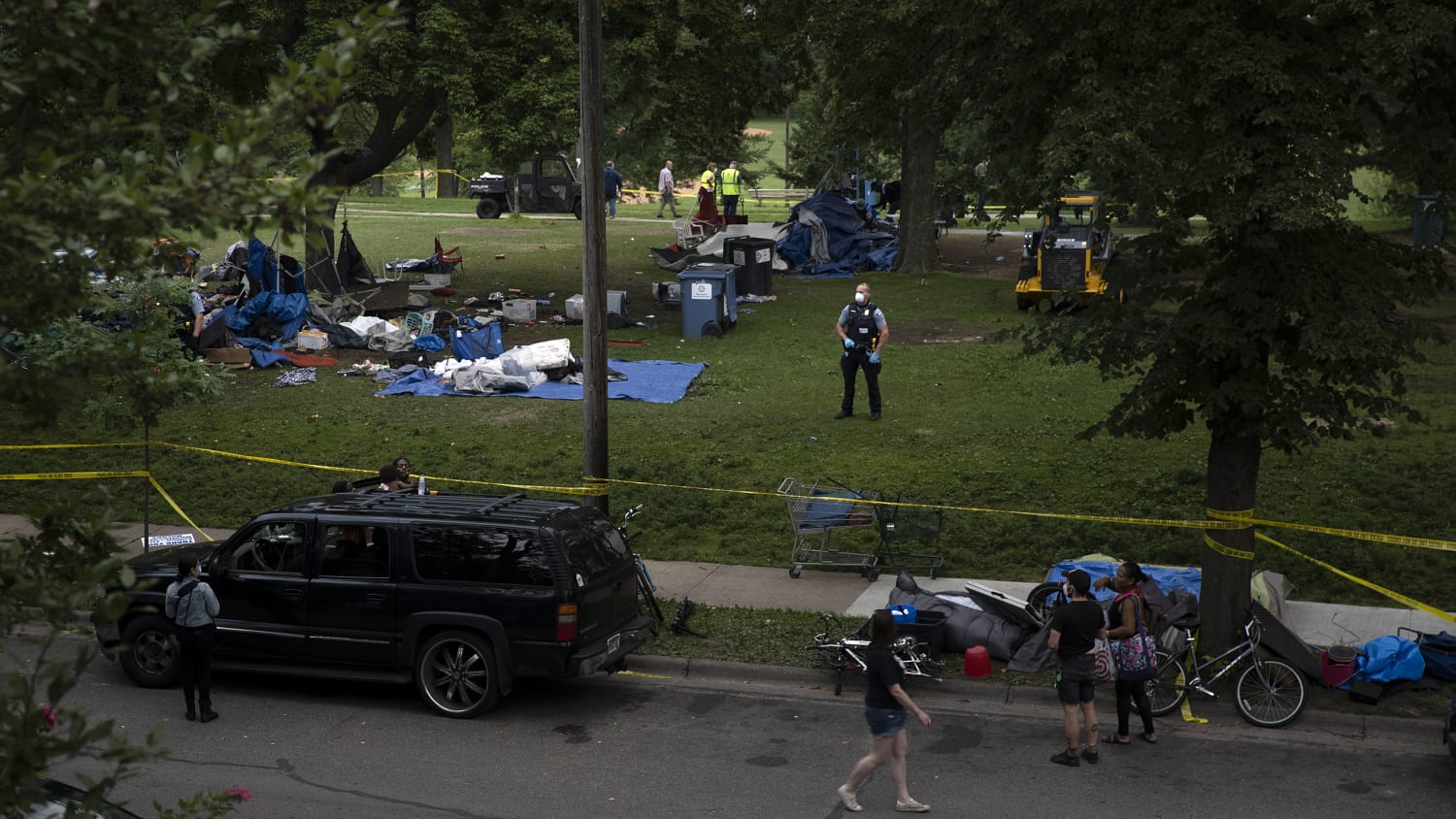
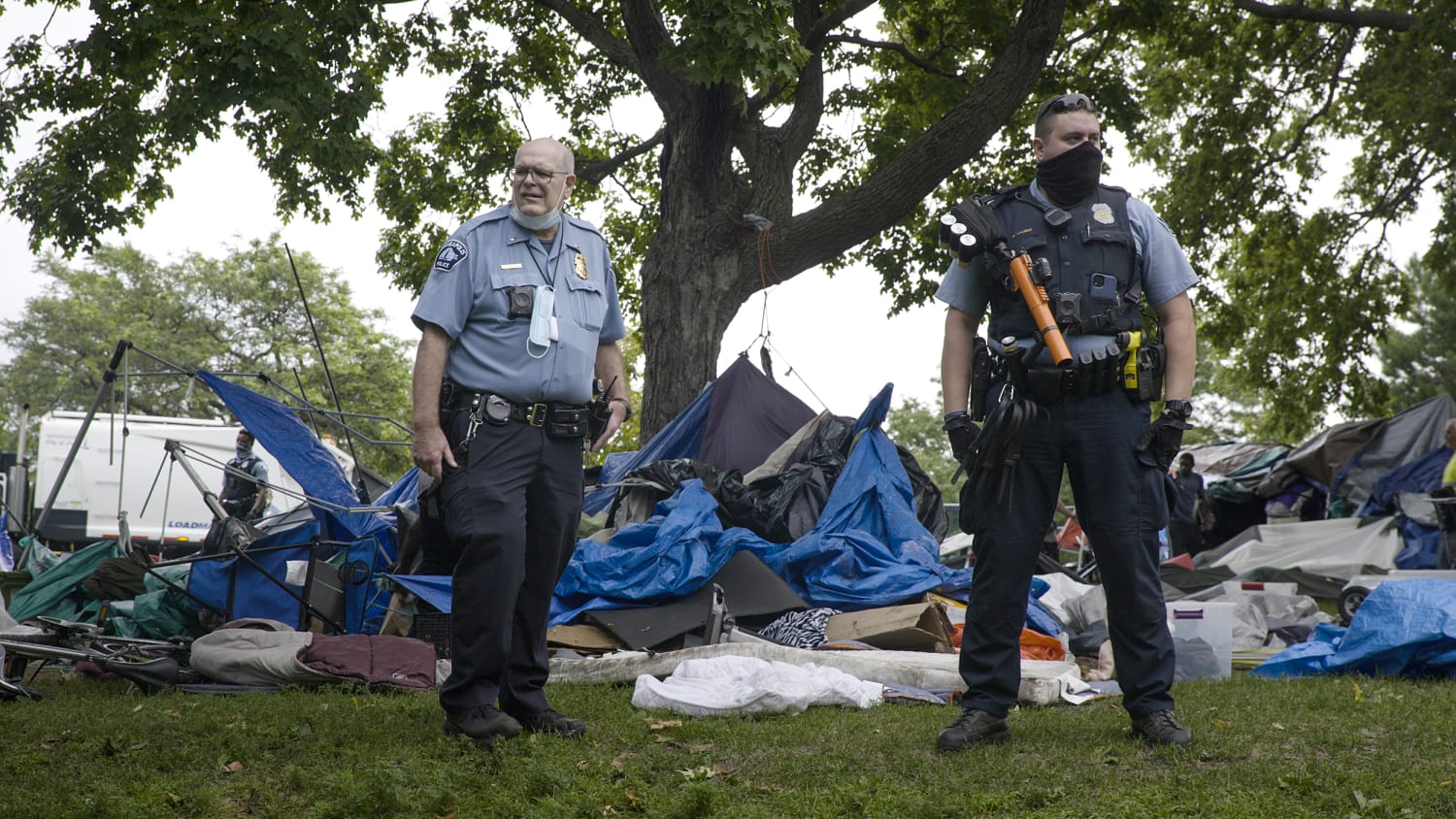
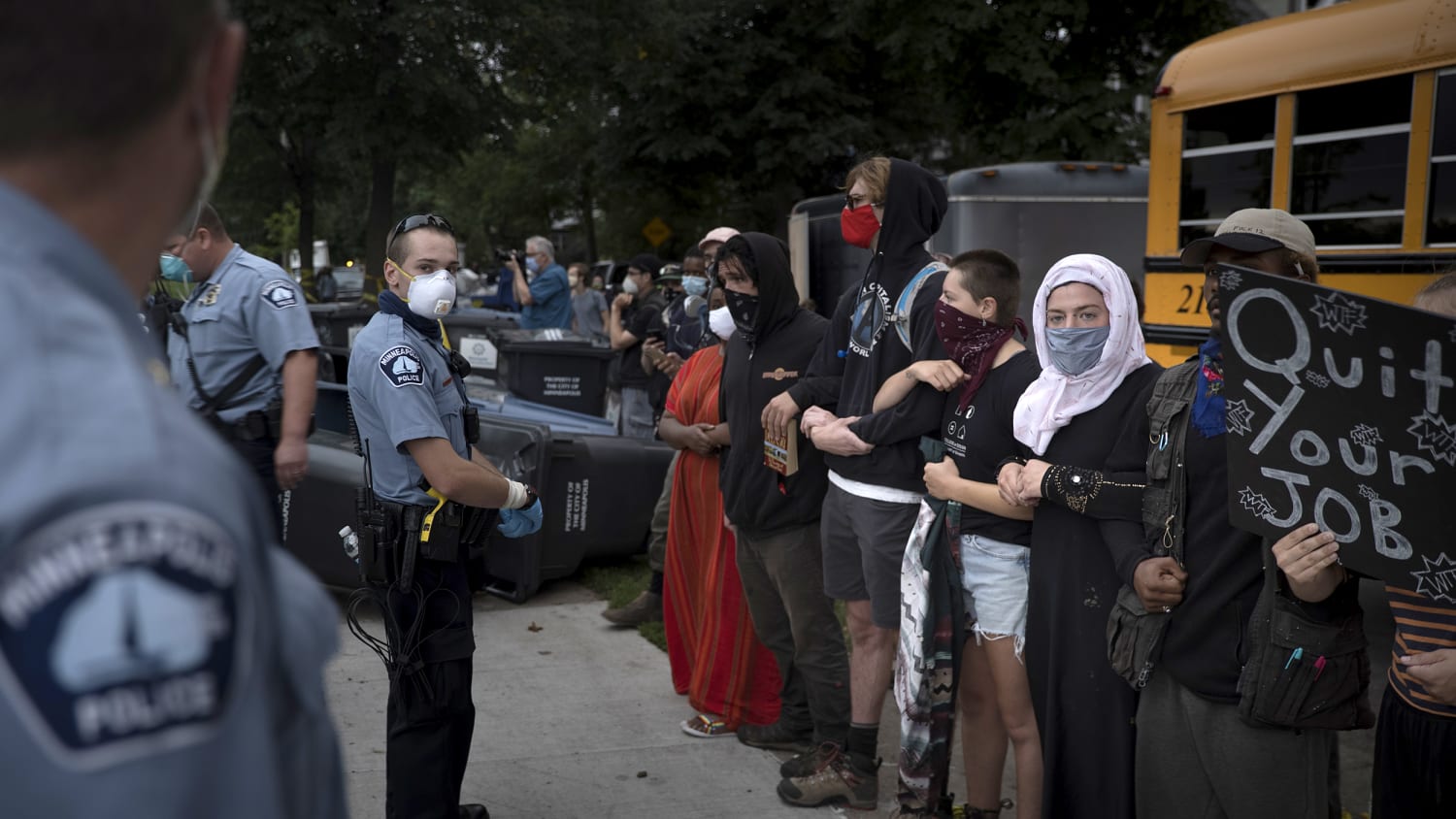
It’s happening all over. Housing advocates fear that when the national moratorium on evictions ends in December, it will result in a new wave of homelessness. Already in 2019, there were roughly 568,000 people experiencing homelessness on a single night in America.
In 2018, a research group documented nearly 4,100 people experiencing homelessness in Hennepin County, with Black people making up 49 percent of homeless adults. Native Americans were 15 percent of the homeless population at the time, despite being only 1 percent of the total population there.
John Tribbett, the street outreach manager at St. Stephen’s Human Services, a homeless services group in Minneapolis, said that while the real number is hard to quantify, in all probability, the amount of people without housing has gone up since the pandemic.
“What's happening in Minneapolis and in our community, it's a microcosm of what's happening across the country. We're just a snapshot,” Tribbett said. “The same stress factors that are showing up here are showing up across the country.”

Cherish Belland kisses her partner Donald Hurd at the Beltrami encampment in Minneapolis on Aug. 17. (Ed Ou/NBC News)
Cherish Belland kisses her partner Donald Hurd at the Beltrami encampment in Minneapolis on Aug. 17. (Ed Ou/NBC News)
As the homeless population in Minneapolis has grown, the pandemic has also limited or closed vital services and public spaces, forcing more people without housing into the open. As a result, the crisis has been playing out in the city’s vast park spaces, housing advocates and local officials said.
Those spaces are already becoming unlivable as winter fast approaches and, with it, the threat of subzero temperatures. In 2019, the Minneapolis–Saint Paul International Airport recorded 91.7 inches of snow. The year before, it saw 82.2 inches. That all makes homelessness here a life or death issue, leaving residents of the encampments and their advocates clamoring for solutions of any kind.
As of Oct. 7, there were 256 tents in 15 parks, according to the Minneapolis Park and Recreation Board, with about 100 along the Midtown Greenway, a bicycle-pedestrian trail. There were also 1,350 people who had stayed in emergency shelters in Heppenin County as of Sept. 29. About 540 people have also been temporarily living in hotels over the last six months, according to Hennepin County's Office to End Homelessness. And the latest reports conducted in January on unsheltered homelessness in the county found more than 640 people living outside in places unfit for human habitation.

Coordinator Junail Anderson cleans the common area of the Logan Park encampment in Minneapolis on Aug. 20. (Ed Ou/NBC News)
Coordinator Junail Anderson cleans the common area of the Logan Park encampment in Minneapolis on Aug. 20. (Ed Ou/NBC News)
“You can’t live in the tents forever. This is Minnesota,” said Junail Anderson, a former coordinator and volunteer at Powderhorn who is Black and was formerly homeless. “We had like four deaths last year, people outside in the cold at the bus shelter hugged up on each other.”
Patrick Berry, 41, who is Native American and lived at Powderhorn, described such horrors as being homeless in the winter and “you wake up and your friend's dead because they died from it being too cold.”
Tribbett’s group works with people who lose limbs because of the cold.
“Our current emergency shelter response system is hundreds of beds short of what is needed to keep folks safely inside during our coldest, and deadliest, months,” he said. And still, the shelter beds only account for the urgent need to get people inside — not the longer-term solutions advocates so desperately want to see for the unhoused.
‘Now we're all under George Floyd law’
Dozens of encampments have sprung up in Minneapolis recently, with some allowed to remain and others, like those at Powderhorn Park, being swept out in evictions. In the wake of the country’s racial reckoning following the death in May of George Floyd here, the camps have become another flashpoint.
Thousands arrived in June to peacefully protest the police killing of Floyd. There were some initial nights of looting and a city-wide curfew was put in place. With all of the unrest, organizers worked to help 200 to 300 homeless people stay in a Sheraton Hotel in the city.

A woman waits for a bus near a closed up Sheraton Hotel on Aug. 28. During the unrest in June following the killing of George Floyd, organizers worked to help 200 to 300 homeless people shelter in the hotel. But after its owner ordered their eviction in June, a growing number of people began setting up their tents at two sites in Powderhorn Park. (Ed Ou/NBC News)
A woman waits for a bus near a closed up Sheraton Hotel on Aug. 28. During the unrest in June following the killing of George Floyd, organizers worked to help 200 to 300 homeless people shelter in the hotel. But after its owner ordered their eviction in June, a growing number of people began setting up their tents at two sites in Powderhorn Park. (Ed Ou/NBC News)
But after the situation at the hotel became unmanageable and its owner ordered their eviction in June, a growing number of people began setting up their tents at two sites in Powderhorn Park. Initially, volunteers and a group of community members rallied behind the camp, providing it with food, medical supplies, tents and other needs.
The resulting encampments drew fierce opposition from some who live in houses nearby, but also support from others who saw them as part of a sanctuary movement for people who otherwise have nowhere else to go.
Londel French, a Minneapolis Park and Recreation board commissioner, was visibly emotional as he watched the destruction of the Powderhorn encampment.
“It is hard and we’re not fixing the problem, and there’s no way the park board can fix the problem. We don’t have the resources or the capacity,” said French, who is Black. “This is the end of a grand experiment of trying to provide sanctuary for folks who don’t have housing. I don’t think everybody is up for a social experiment like that.”
And still the fate of those who were shuffled from that park to places unknown remains unclear.

Demonstrators hold a candlelight vigil for victims of police shootings at the site of the memorial for George Floyd in Minneapolis on Aug. 30. (Ed Ou/NBC News)
Demonstrators hold a candlelight vigil for victims of police shootings at the site of the memorial for George Floyd in Minneapolis on Aug. 30. (Ed Ou/NBC News)
“They did George Floyd, and now we're all under George Floyd law. They can step on us at any time,” said Rodney Williams, a Black man who previously lived at the Powderhorn encampment. “If I came and brought a bulldozer to your house, how would you feel?”
The sense of endlessness to this cycle is wearing on many.
“It’s really heartbreaking, watching people get displaced over and over without resolutions,” said Sheila Delaney, a longtime community and housing advocate. “It hurts me in every way.”
‘To me, it was home’
By the time the encampment at Powderhorn was demolished in mid-August, it had come to mean a lot of different things to a lot of different people.
“For me, it was an intentional community,” Berry, the Native American man who lived at the park, said. “For other people, it was kind of a party at times. For other people, it was a type of nightmare, bad things happened to them.”
Two encampments at Powderhorn eventually grew to some 600 tents with nearly 300 people at its height, but after some overdoses and crime, including several sexual assaults and shootings, that location was dismantled over safety concerns.
“To live in a large tent encampment that resembles a refugee camp in America is very incredibly depressing to some folks,” Berry said. “But overall, I mean, to me, it was home. I made sure to stay close to the volunteers because that was a safer place to be.”

Patrick Berry, 41, packs his belongings into a bag at the "Say Their Names" memorial in Minneapolis on Aug. 16. Patrick has drifted in an out of homelessness since he was a teenager. (Ed Ou/NBC News)
Patrick Berry, 41, packs his belongings into a bag at the "Say Their Names" memorial in Minneapolis on Aug. 16. Patrick has drifted in an out of homelessness since he was a teenager. (Ed Ou/NBC News)

Patrick Berry smokes a cigarette at an encampment known as “The Wall of Forgotten Natives” in Minneapolis on Sept. 3. (Ed Ou/NBC News)
Patrick Berry smokes a cigarette at an encampment known as “The Wall of Forgotten Natives” in Minneapolis on Sept. 3. (Ed Ou/NBC News)
Beth Holger, CEO of The Link, an organization that works with youth who are homeless or victims of sex trafficking, said that unfortunately when the encampments got larger, children became more vulnerable to sexual assaults and exploitation as people could come in to prey on them.
“Oftentimes, the people that are living there are the ones that are the target of it, so it’s not like necessarily these people that are experiencing homelessness are the ones that are causing all these crimes. It’s oftentimes they’re getting preyed upon by other people due to their vulnerabilities,” she said, adding her group has been working on a number of difficult cases from the encampments.
French said that when homeless women are sexually assaulted, they rarely report it. In comparison, when the assaults happened at Powderhorn, there was medical staff there to help the women, take them to the hospital and report the crimes, he said.
“When people see the despair, abuse and the predatory behavior that’s thrust upon unsheltered people, then it becomes a problem,” he said. “It’s not a problem when it’s under a bridge where no one can see it.”
Holger, who is white, said that overall, the pandemic has created an “overwhelming demand” for her organization’s services because of a reduction in shelter beds and aid in the area. At the same time, in the aftermath of Floyd’s death, she has seen people really come together in new ways to help the homeless community.
“You’re also seeing the best of humanity coming together, too,” she said.
‘They were scared they're going to die alone’
In the wake of the Powderhorn eviction, the park board eventually ended up passing restrictions, including limiting encampments to 25 tents and setting up a permit process. The evictions remain highly controversial among supporters of the camps, as well as the volunteers and residents who help them on a daily basis with everything from food and water to their own internal security.
The result is a series of camps where volunteers, not only from the outside community, but also residents themselves, share supplies. Each camp also has its own internal politics, dynamic and struggles.
Junail Anderson, the former coordinator and volunteer at Powderhorn, helped create two encampments at Logan Park and Beltrami Park, bolstered by volunteers and other residents. She is also a co-founder of Freedom From the Streets, a group made up of people who are homeless, formerly homeless or on the verge of homelessness.
At Logan Park, two dozen colorful tents form a circle and, in the center, there is a large blue supply tent with food, hygiene supplies, medicine and coolers with water and sports drinks. Anderson or volunteers open the tent at around 8 a.m. every morning and prepare for the day ahead.

Donated hygiene supplies are seen at the Logan Park homeless encampment in Minneapolis on Aug. 17. (Ed Ou/NBC News)
Donated hygiene supplies are seen at the Logan Park homeless encampment in Minneapolis on Aug. 17. (Ed Ou/NBC News)

Rodney Williams helps a new resident find supplies in the homeless encampment at Logan Park in Minneapolis on Aug. 17. (Ed Ou/NBC News)
Rodney Williams helps a new resident find supplies in the homeless encampment at Logan Park in Minneapolis on Aug. 17. (Ed Ou/NBC News)
Donated meals arrive during the day, and there are portable bathrooms. Volunteer services allow residents to do laundry once a week. There are barbecues on some weekends where people can gather to eat and share a laugh. Other days there are heated arguments among the residents that need to be ironed out.
Anderson, 44, said the encampment combats a basic fear.
“They were scared they're going to die alone,” she said of the area’s homeless people. “We made a big impact where people that's homeless could stay together.”
Anderson, who is Black, said while there has been a lot of community support, people also regularly yell obscenities while they walk or drive past.
“These neighbors have a lot of these signs that's got Black Lives Matter up here, and they really don't care about us,” she said.
Tensions can sometimes flare between residents as many of them carry years of trauma, mental health issues, and current or former substance abuse issues, said James Blake, one of the main volunteers at Logan Park.

Volunteers from the community carry bags of laundry belonging to the homeless residents of the Logan Park encampment in Minneapolis on Aug. 17. (Ed Ou/NBC News)
Volunteers from the community carry bags of laundry belonging to the homeless residents of the Logan Park encampment in Minneapolis on Aug. 17. (Ed Ou/NBC News)

Encampment coordinator Junail Anderson, left, speaks to volunteer James Blake at the Logan Park encampment in Minneapolis on Aug. 17. (Ed Ou/NBC News)
Encampment coordinator Junail Anderson, left, speaks to volunteer James Blake at the Logan Park encampment in Minneapolis on Aug. 17. (Ed Ou/NBC News)
Help for them can involve all kinds of outreach, from getting someone connected with a medic, setting up a resident with a cellphone, helping someone find treatment options or Bible study, or booking a veterinary appointment for a resident’s dog, said Blake, 26, who identifies as nonbinary and is white.
“Everybody’s traumatized there,” they said. “They’re fully immersed in trauma on a daily basis. It’s tragic.”
Rodney Williams, the former Powderhorn resident, followed Anderson to Logan Park, where he said the goal was to create a sense of community for residents under the park board rules.
“In this sanctuary, everybody means something,” Williams said. “It wasn’t just about, hey, this person has nowhere to lay their head.”
Williams helps run security at the park, where things often become tense after dark. He has had to kick people out, and deal with issues such as people raiding their supply tent at night.

Rodney Williams plays on his phone inside his tent at the homeless encampment at Logan Park in Minneapolis on Aug. 17. Williams has been managing mental health issues and moving around different encampments. He runs security at the Logan Park encampment, where he tries to create a sense of community among residents. (Ed Ou/NBC News)
Rodney Williams plays on his phone inside his tent at the homeless encampment at Logan Park in Minneapolis on Aug. 17. Williams has been managing mental health issues and moving around different encampments. He runs security at the Logan Park encampment, where he tries to create a sense of community among residents. (Ed Ou/NBC News)
“We're vulnerable every night. But at that instant, it takes faith,” he said.
Williams criticized the park board’s decision to limit the size of the encampments to 25 tents given how dangerous it can be for people on their own. One day he broke down in tears about how he had to turn people away who wanted a place to stay because they were at capacity.
“How do you turn somebody down that has no place to go?” he said.
‘We understand that the park is not a solution’
Many have been working hard to find more stable options for those living in the encampments.
Samantha Pree-Stinson, a community activist and organizer who is Native American, facilitated an encampment for women, where the goal was to have everyone on some pathway to housing or treatment before the cold sets in.
“We understand that the park is not a solution. We just connect people to the resources they need,” she said. “By the time the winter comes, every woman who has come through that encampment will have gotten the services that they need.” The encampment closed in early October.
Blake said there were plans to transition residents from Logan Park into a hotel in mid-October and in November. The volunteers would then help run a 24-hour shelter for the former park residents.

The sun sets over the tent encampment at Logan Park in Minneapolis on Aug. 16. (Ed Ou/NBC News)
The sun sets over the tent encampment at Logan Park in Minneapolis on Aug. 16. (Ed Ou/NBC News)

A resident in Logan Park plays with a turtle on Aug. 22. (Ed Ou/NBC News)
A resident in Logan Park plays with a turtle on Aug. 22. (Ed Ou/NBC News)
Other shelter plans have been in the works, too. In July, city and county officials announced they were using federal coronavirus aid in part to assist with the opening of three shelters with more than 100 beds serving three groups: women, Native Americans and medically frail homeless people leaving the hospital.
Pree-Stinson said shelters or hotels aren’t immune from crime or violence and are sometimes considered unsafe by those they aim to help. The spaces are also not always run in culturally competent ways for racial minorities or the LGBTQ community, she said.
“It's not part of a pathway to get them to a more permanent secure housing, whether that's buying a house or renting it, an apartment, a tiny home, a cooperative, whatever it might be,” she said.
Indoor Villages represent one type of low-barrier solution: a community of 100 tiny homes that would have easy access to mental health services, drug dependency treatment and assistance in finding housing, for instance.
“Indoor Villages is a bridge. You have your own tiny place and then you’ll be surrounded by services that you can use,” said Sheila Delaney, the housing advocate. Residents won’t be required to use those services if they aren’t ready and won’t risk losing their placement if they don’t, as in other programs.
The space could open in late November or early December thanks to initial funding allocated by the city, Delaney said. Approximately 250 to 300 people could cycle through the two-year pilot project program per year.
Another similar project, Envision, would create a community of about two dozen tiny homes. The population would break down to 20 percent people who are chronically homeless and have complex health needs, 60 percent people who have experienced housing instability and homelessness, and the remaining 20 percent people who have never experienced homelessness.

A model for Envision, a proposed tiny homes project that would house a mix of people who have faced chronic homelessness, some homelessness/housing instability and never experienced homelessness. (Ed Ou/NBC News)
A model for Envision, a proposed tiny homes project that would house a mix of people who have faced chronic homelessness, some homelessness/housing instability and never experienced homelessness. (Ed Ou/NBC News)
“It’s this intentional mixture of people that creates a diverse social network from across the housing spectrum,” said Bill Walsh, a surgeon and an adviser for the project, which is pending on confirmed financing and location.
David Hewitt, director of the Hennepin County's Office to End Homelessness, said there were currently about 540 people 60 and older who have medical complications that had been staying in hotels for six months at the cost of $2.5 million per month, money that comes from the federal CARES Act funding, which is set to run out at the end of the year.
“There've been unprecedented efforts this year,” he said, adding that the county was “stretching our service providers in ways we never have before in the face of multiple crises, and we all still fully acknowledge that it’s not enough.”
From January to June of this year, the county saw 1,363 exits from homelessness to permanent housing, a slight rise from the 1,269 from the same time period in 2019, according to county data.
Overall, the county has allocated more than $35 million in CARES Act-related funds to address homelessness, including $10 million for hotels, $15 million in rental assistance, about $3.2 million for shelter rehabilitation, $3.5 million for a new shelter in partnership with the American Indian Community Development and another $3.5 million for the recent purchase of a motel and former treatment facility to house people experiencing homelessness, Hewitt said.
“The underlying housing crisis that predated Covid meant that there are tens of thousands of households that simply have no way of affording housing in our market,” Hewitt said.
‘Anybody can be homeless’
Across a bridge from Logan, Latrice Steward lived at Beltrami Park with her three children, ages 1, 6 and 14, and her partner, Jerome, who works nights at a major delivery company. The family, who are Black, are experiencing homelessness for the first time and were making do in a blue and orange tent.
Before she lived in the park, Steward worked on the front lines of the fight against the coronavirus pandemic, tending to nursing home residents in Minneapolis as a certified nursing assistant.
Steward, 34, would spend time with elderly residents of nursing homes, some of whom had dementia. She dressed and fed them, helping them use the bathroom and turning them to avoid bedsores. The job came with a fair share of heartache, as three people died from Covid-19 at the facility where she worked.
She described watching patients die, gasping for air when the day before she had seen them “playing cards at the table, drinking your coffee, doing your hair.”
“That’s the hardest part of Covid,” she said. “That hit me.”
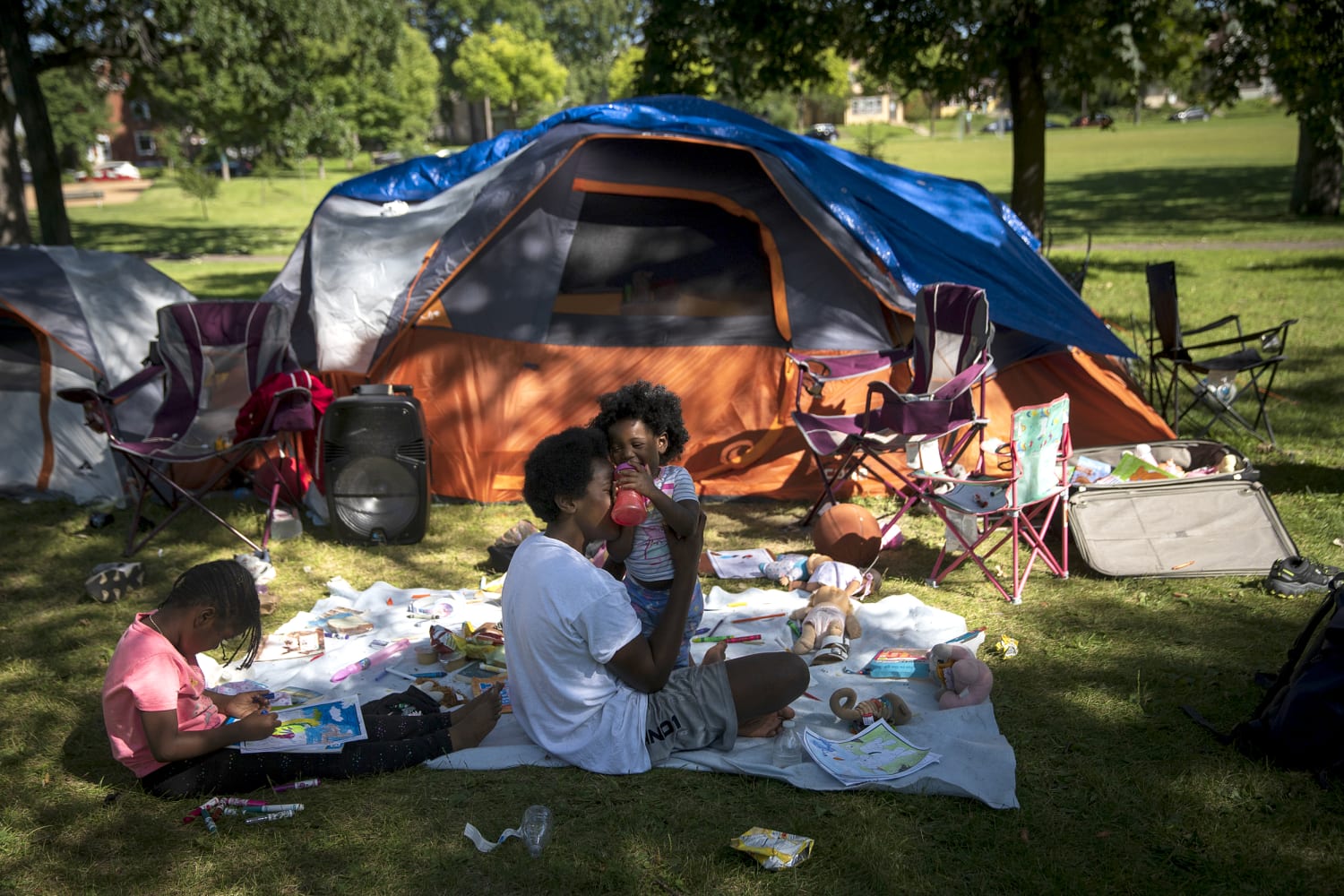
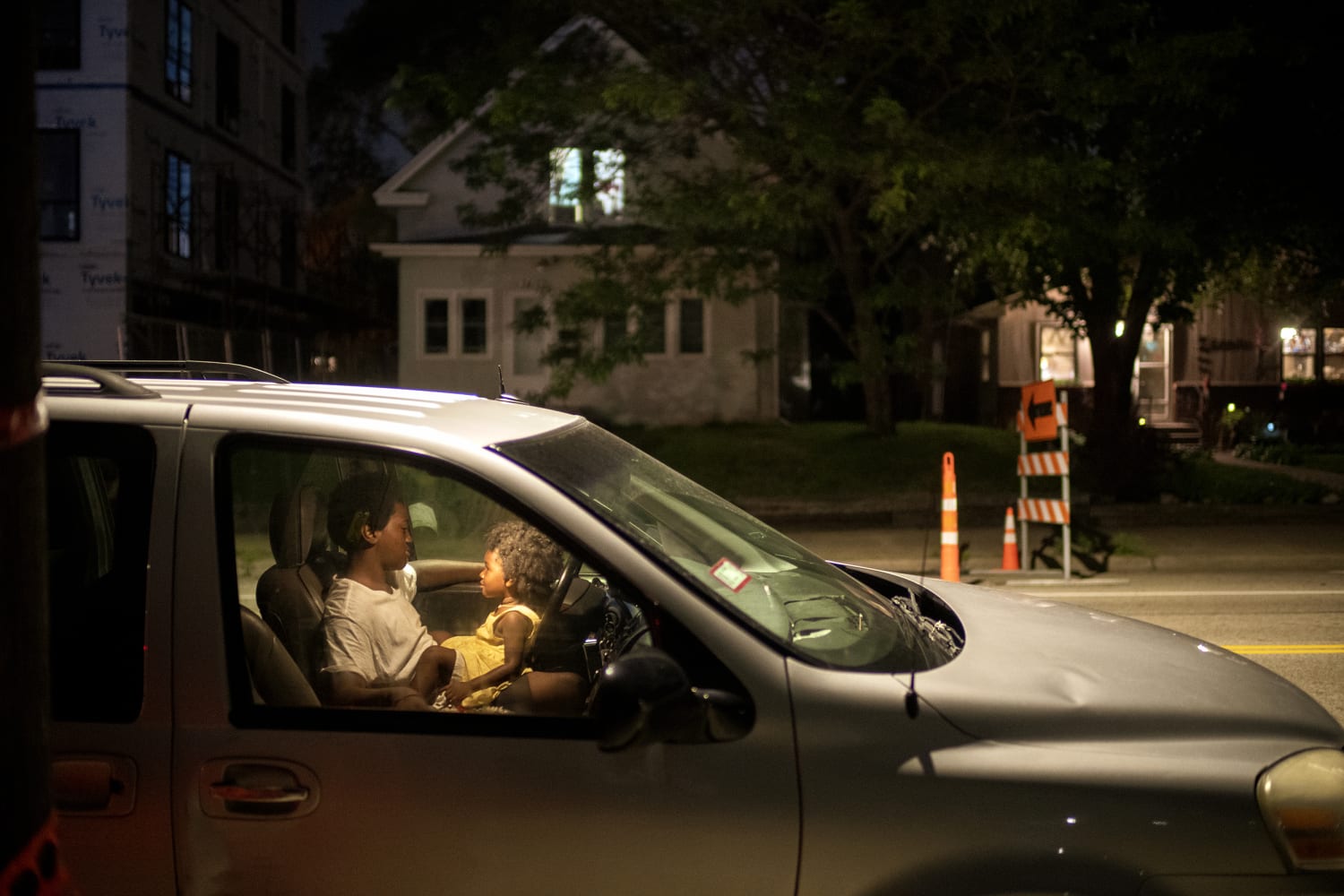
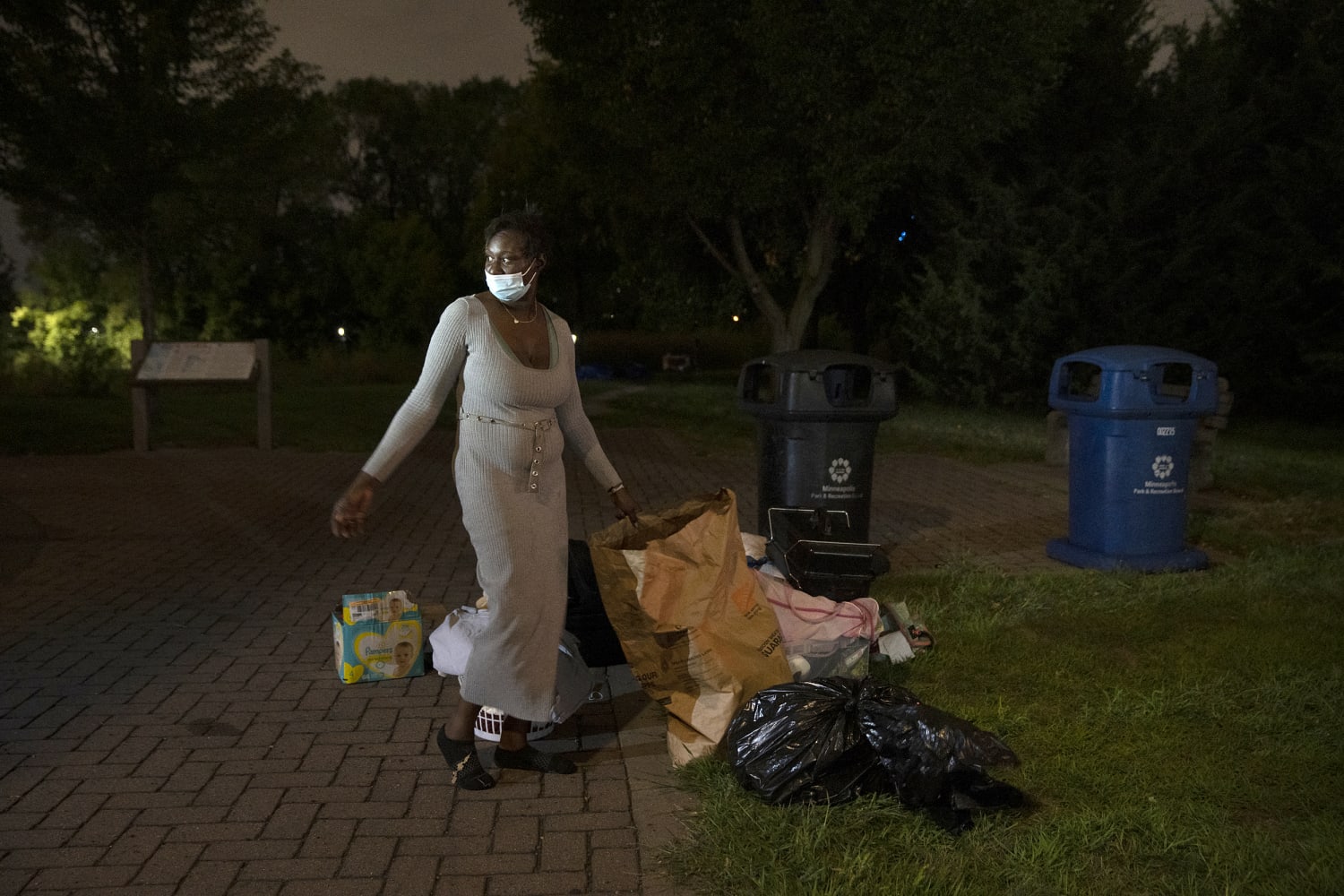


Still, she said, “if somebody needed me for Covid to suit up and boot up, I’d do it all over again.”
Now, she wants others to know homelessness can happen to anyone. A bitter falling-out with the family she was staying with ended with her family losing their housing and her eventually losing her job.
Steward said she knows they won’t be homeless forever. She hopes to one day get a job that will allow her to give back to the homeless community for the way it has helped her.
The immediate challenge, however, is finding affordable housing despite having a poor credit score and being unable to afford several months of rent in advance and application fees.
“Anybody can be homeless,” she said. “I have never thought in my life I would end up in this situation.”

Latrice Steward and her family rest in a hotel room in Bloomington, Minn., on Aug. 21. A local non-profit made arrangements for them to stay at the hotel for about two weeks. (Ed Ou/NBC News)
Latrice Steward and her family rest in a hotel room in Bloomington, Minn., on Aug. 21. A local non-profit made arrangements for them to stay at the hotel for about two weeks. (Ed Ou/NBC News)
Steward said she had this message for those passing by the tents: “They'll yell slurs or throw their middle finger up instead of them having a heart. You don't even know, I probably took care of your grandma in the nursing home I was just working at.”
Steward was still working hard, taking job interviews and searching for apartments or mobile homes for sale to get her family out of the tents as temperatures were starting to drop into the 40s in late September.
She and her family had been going back and forth between the parks and a hotel room provided by a local nonprofit. But the weather meant that when they were in the park, they slept in their car as it was too cold in tents.
“That’s the biggest concern: It’s the cold,” she said. “I’ve got kids. I have a 1-year-old. This is definitely not liveable. I’ve just got to work my way out of this situation.”
